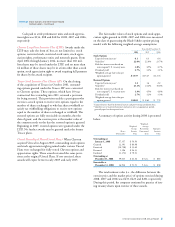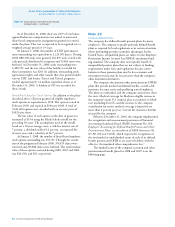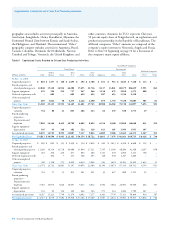Chevron 2008 Annual Report Download - page 91
Download and view the complete annual report
Please find page 91 of the 2008 Chevron annual report below. You can navigate through the pages in the report by either clicking on the pages listed below, or by using the keyword search tool below to find specific information within the annual report.
Chevron Corporation 2008 Annual Report 89
It is likely that the company will continue to incur
additional liabilities, beyond those recorded, for environ-
mental remediation relating to past operations. These
future costs are not fully determinable due to such factors
as the unknown magnitude of possible contamination, the
unknown timing and extent of the corrective actions that
may be required, the determination of the company’s liability
in proportion to other responsible parties, and the extent to
which such costs are recoverable from third parties.
Refer to Note 24 below for a discussion of the company’s
Asset Retirement Obligations.
Equity Redetermination For oil and gas producing operations,
ownership agreements may provide for periodic reassess-
ments of equity interests in estimated crude oil and natural
gas reserves. These activities, individually or together, may
result in gains or losses that could be material to earnings in
any given period. One such equity redetermination process
has been under way since 1996 for Chevron’s interests in four
producing zones at the Naval Petroleum Reserve at Elk Hills,
California, for the time when the remaining interests in these
zones were owned by the U.S. Department of Energy. A wide
range remains for a possible net settlement amount for the
four zones. For this range of settlement, Chevron estimates
its maximum possible net before-tax liability at approxi-
mately $200, and the possible maximum net amount that
could be owed to Chevron is estimated at about $150. The
timing of the settlement and the exact amount within this
range of estimates are uncertain.
Other Contingencies Chevron receives claims from and sub-
mits claims to customers; trading partners; U.S. federal, state
and local regulatory bodies; governments; contractors; insur-
ers; and suppliers. The amounts of these claims, individually
and in the aggregate, may be significant and take lengthy
periods to resolve.
The company and its affiliates also continue to review
and analyze their operations and may close, abandon, sell,
exchange, acquire or restructure assets to achieve operational
or strategic benefits and to improve competitiveness and prof-
itability. These activities, individually or together, may result
in gains or losses in future periods.
Note 24
Asset Retirement Obligations
The company accounts for asset retirement obligations
(ARO) in accordance with Financial Accounting Standards
Board (FASB) Statement No. 143, Accounting for Asset Retire-
ment Obligations (FAS 143) and FASB Interpretation No. 47,
Accounting for Conditional Asset Retirement Obligations – An
Interpretation of FASB Statement No. 143 (FIN 47). FAS 143
applies to the fair value of a liability for an ARO that is
recorded when there is a legal obligation associated with the
retirement of a tangible long-lived asset and the liability can
be reasonably estimated. Obligations associated with the
retirement of these assets require recognition in certain cir-
cumstances: (1) the present value of a liability and offsetting
asset for an ARO, (2) the subsequent accretion of that liabil-
ity and depreciation of the asset, and (3) the periodic review
of the ARO liability estimates and discount rates. FIN 47
clarifies that the phrase “conditional asset retirement obliga-
tion,” as used in FAS 143, refers to a legal obligation to
perform asset retirement activity for which the timing and/or
method of settlement are conditional on a future event that
may or may not be within the control of the company. The
obligation to perform the asset retirement activity is uncondi-
tional even though uncertainty exists about the timing and/
or method of settlement. Uncertainty about the timing and/
or method of settlement of a conditional ARO should be fac-
tored into the measurement of the liability when sufficient
information exists. FAS 143 acknowledges that in some cases,
sufficient information may not be available to reasonably esti-
mate the fair value of an ARO. FIN 47 also clarifies when an
entity would have sufficient information to reasonably esti-
mate the fair value of an ARO.
FAS 143 and FIN 47 primarily affect the company’s
accounting for crude oil and natural gas producing assets.
No significant AROs associated with any legal obligations to
retire refining, marketing and transportation (downstream)
and chemical long-lived assets have been recognized, as inde-
terminate settlement dates for the asset retirements prevent
estimation of the fair value of the associated ARO. The com-
pany performs periodic reviews of its downstream and chemical
long-lived assets for any changes in facts and circumstances
that might require recognition of a retirement obligation.
The following table indicates the changes to the com-
pany’s before-tax asset retirement obligations in 2008, 2007
and 2006:
2008 2007 2006
Balance at January 1 $ 8,253 $ 5,773 $ 4,304
Liabilities incurred 308 178 153
Liabilities settled (973) (818) (387)
Accretion expense 430 399* 275
Revisions in estimated cash flows 1,377 2,721 1,428
Balance at December 31 $ 9,395 $ 8,253 $ 5,773
*
Includes $175 for revision to the ARO liability retained on properties that had
been sold.
In the table above, the amounts associated with “Revisions
in estimated cash flows” reflect increasing costs to abandon
onshore and offshore wells, equipment and facilities, includ-
ing an aggregate of $1,804 for 2006 through 2008 for the
estimated costs to dismantle and abandon wells and facilities
damaged by hurricanes in the U.S. Gulf of Mexico in 2005
and 2008. The long-term portion of the $9,395 balance at the
end of 2008 was $8,588.
Note 23 Other Contingencies and Commitments – Continued
























